Games
PCB
Archive
Chip
Archive
Cart/Box
Scans
Articles
Peripherals
Prototypes
Unreleased
Games
Rarities
Homebrew
Emulation
Links
Email: snes_central@yahoo.ca
Smartball

| Game Code: | JB | Genre: | Action/ Platform |
| US Title: | Smartball | US Publisher: | Sony Imagesoft |
| Japan Title: | Jerry Boy | Japan Publisher: | Epic/ Sony Records |
| Title in Kanji: | Title in Kana: | ||
| European Title: | Europe Publisher: | - | |
| Developer: | Sony/Epic | Players: | 1 |
| Accessories: | none | Special Chips: | none |
| Save: | none |
 Smart Ball is a platform game in which players control Jerry, a young prince who has been transformed into a blob by by an evil wizard, as he runs, hops, climbs, and stretches himself across 16 unique stages. Known as Jerry Boy in Japan, the game was developed by Gamefreak, and published by Sony Imagesoft. By:
Michael Burns
|
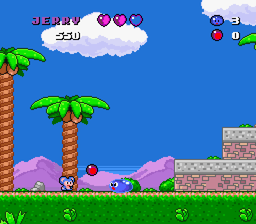 |
| A mean game of hot potato… |
Believe it or not, there was a time in Nintendo's recent history in which Gamefreak, developer of the best-selling Pokemon series of handheld RPGs, was not a hot commodity. Their first foray into platforming, Smart Ball, is often overlooked, perhaps unfairly. In an era where developers were busy trying to make their games stand out by exploiting the graphical capabilities of Nintendo's relatively new Super Famicom hardware, Gamefreak chose instead to stick (mostly) to a time-tested design that had proven itself with any number of Famicom/NES games. Is Smart Ball worth checking out, or is there a reason it completely failed to register in the collective consciousness of gamers everywhere? Read on to find out!
Story
At the beginning of Jerry Boy, as Smart Ball is known in Japan, we learn that all is not well within the walls of our hero Prince Jerry's castle. One day, while Jerry chats idly with his betrothed, the beautiful Emi, Jerry's brother Tom, clearly jealous, plots with a mysterious wizard to put an evil curse on Jerry, thus opening up Emi's availability and, presumably, the throne, for Tom. The resulting curse turns Jerry into a blob, and he soon finds himself on a quest to defeat the wizard, reunite with Emi, and sort out this business with Tom once and for all. As clichéd as Jerry Boy's story is, American gamers confronted with Smart Ball are left in the dark about it, as Sony Imagesoft made the baffling decision to remove all reference to this tale of familial discord from the game's Western release, save for the ending sequence. I won't spoil it here, but suffice to say, Smart Ball's ending, bereft of any context, is both sufficiently confusing and highly amusing.
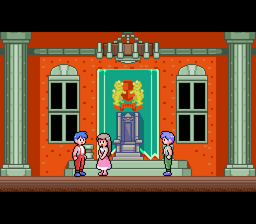 | 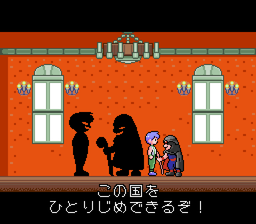 |
| Someone's jealous. | Up to no good. |
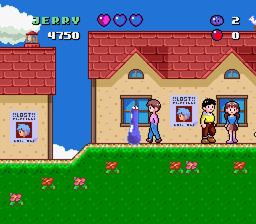 | 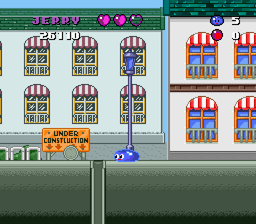 |
| Gathering the scuttlebutt! | Lost in translation. |
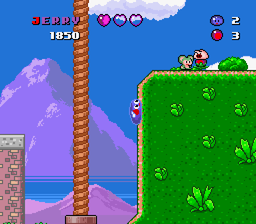 |
| A mouse and a pig walked into a bar... |
Gameplay
Despite Jerry's lack of arms and legs, Smart Ball plays exactly as you'd expect a platformer to, with a few twists that set it apart from its contemporaries. Jerry can run, jump, swim, and throw projectiles at enemies, and players well versed in this type of game will be right at home with this skill set. However, the game also extends Jerry's repertory of moves with a few unique actions that make use of his newfound jelly-like physiology. In addition to his inexplicable ability to throw rubber and iron balls at enemies (look ma, no arms!), Jerry can also attack by either flattening or stretching himself into enemies, and it's this ability that will serve players best through most of the game's boss fights. Jerry can also move across walls and ceilings, though this only rarely translates into uniquely-designed platforming or cleverly hidden secret areas.
While Jerry's unique abilities may set Smart Ball apart from other platformers, they also hinder the game somewhat, as the timing and precision required to do anything useful with them are pretty difficult to ascertain. Players may find themselves quickly approaching the end of the game by the time they've gotten a firm grasp on Smart Ball's controls. It's also worth noting a couple of the game's quirks: players will not be able to pick up life points while holding any of Jerry's handful of available powerups; additionally, Jerry can only hold 9 balls - if he picks up another one, the count will reset to zero. These issues aside, Smart Ball is not a difficult game, though hidden letters spelling out "JERRY" (a là Donkey Kong Country's "KONG" letters) extend the replayability of most of the game's sixteen levels.
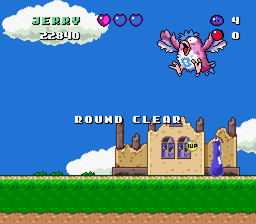 |
| Nobody messes with Jerry! |
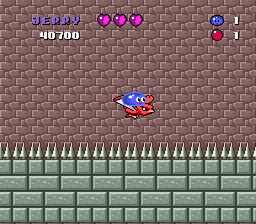 |  |
| someone played Super Mario Bros 2… | Whuh-oh! |
Graphics and Sound
 |
| Mode 7 is used sparingly. |
Smart Ball, despite appearing on the Super NES, looks surprisingly close to an 8-bit NES game. Despite that, levels are bright and cartoony, offering plenty of variety in the form of towns, deserts, forests, oceans, dungeons, arctic tundra, and even a Mode 7 romp across both the light and dark sides of the moon. Conversely, character and enemy sprites are, for the most part, generally just detailed enough to be charming. There are a few notable exceptions here: bosses, for example, are mostly interesting to look at, and two specific enemy types featured in later levels - both naked men - are downright disturbing (and, as an aside, their mere existence in this kid-friendly title lends further mystery to Sony's decision to cut other elements from the game.)
Smart Ball's soundscape is certainly interesting. While audio effects are unremarkable, there is a surprising amount of artistry to the game's 22 different music tracks. Many levels are accompanied by the upbeat calypso beats stereotypical of platform titles, but other tracks evoke wholly different moods: towns are accompanied by a breezy Mediterranean theme, while a boss fight in a church is underscored by appropriately gothic pipe organs. Other stand out tracks include the music accompanying the brief moon levels and the water level track called "Waterworld," which both easily rival the music in a certain other previously-mentioned SNES platformer for sheer ambiance. In fact, all things considered, Hirohiko Fukuda's compositions may just be the best reason to play through Smart Ball.

Summary
While it may not break the mold, Smart Ball is worth checking out for fans of both Gamefreak and SNES platformers in general, if only to see how far the company and the genre have come since then. Having said that, I'd recommend that players considering a purchase of Smart Ball instead track down a copy of Jerry Boy, which, besides having its opening story sequence intact, also contains a number of interstitial areas that present a nice break from the admittedly easy platforming sequences on offer here.
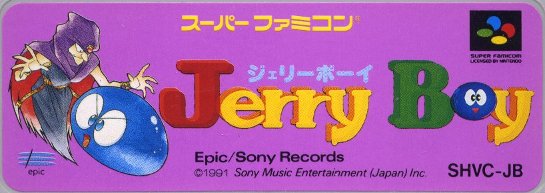
Prototypes
| Region | Cart/PCB scan | Dump Status | State of Completion | Source | Notes | Details |
|---|---|---|---|---|---|---|
| Japan | yes | dumped | final | prototype cartridge | Bitwise identical to the Japanese version of the game | link |
Cartridge label information
| Region | Country | Serial Code | notes | Scan |
|---|---|---|---|---|
| Americas | USA | SNS-JB-USA | regular release | link |
| Asia | Japan | SHVC-JB | regular release | link |
Do you have a label variant that is not listed above or a better quality copy? Read the Submission guidelines for cartridge label scans.
PCB Information
| ROM Chip ID | Region | Known Man. Dates | PCB Type | CIC | SRAM | Decoder/ Logic Circuit | Special Chips |
|---|---|---|---|---|---|---|---|
| Prototype (front) (back) | Japan | - | SHVC-2P3B-01 | D411A | 74LS139 | - | - |
| SHVC-JB-0 (front) | Japan | 9131 | SHVC-1A0N-01 | D411 | - | - | - |
| SNS-JB-0 (front) | USA | 9207 | SHVC-1A0N-01 | D411 | - | - | - |
Do you have a PCB with a different ROM chip ID, PCB type or manufacturing date? Read the Submission guidelines for PCB scans.
Box information
| Region | Country | Serial Code | notes | Front scan | Back scan |
|---|---|---|---|---|---|
| Americas | USA | SNS-JB-USA | regular release | link | link |
Do you have a box variant that is not listed above or a better quality copy? Read the Submission guidelines for box scans.
Published Review Scores
| Nintendo Power | Publication date: March 1992 |
Issue: 34 | Page: 105 |
| Graphics and Sound: 3.3/5 | Play Control: 3.0/5 | Challenge: 3.2/5 | Theme and Fun: 3.4/5 |
Bibliography
- Nintendo Power, Super NES Showcase (Rumour about the game - as Jellybean), Publication date: May 1991, Volume: 24, Pages: 96
- Nintendo Power, George and Rob's Now Playing (short review of the game), Publication date: March 1992, Volume: 34, Pages: 104-105
- Nintendo Power, Review, Publication date: March 1992, Volume: 34, Pages: 105
- Nintendo Power, Classified Information (stage select code), Publication date: December 1992, Volume: 43, Pages: 26